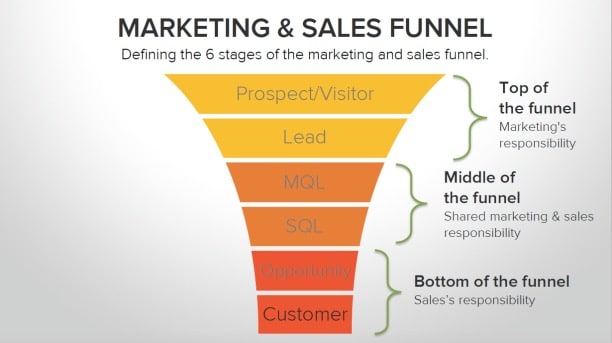How to Align Sales and Marketing Teams

Is your sales and marketing relationship broken?
So you’re a marketer, and it’s tough meeting the expectations of your sales team. Or you’re a salesperson, and you’re struggling to understand why marketing keeps misfiring. Firstly, don’t worry it’s not a unique situation – it’s standard and its the primary reason that holds back sales and marketing teams back from being successful.
Did you know that a healthy relationship between your sales and marketing teams is integral to a robust inbound marketing strategy? In this short article we look to share the best practice for aligning sales and marketing teams, so they are working as an unstoppable collective. The two teams are intrinsically linked: marketing teams generate leads while sales teams take those leads and turn them into paying clients. However, sales and marketing don’t always see eye to eye. Sales employees tend to minimise the work that goes into generating leads and marketing employees often refer to sales employees as lazy. It’s the sort of thing that sends leadership team across the country crazy.
That said, the collaboration between the two can help your business grow exponentially. In fact, when your company has a substantial alignment between sales and marketing, you could get an average of 23% more revenue growth. Ensuring that sales and marketing are aligned is even more helpful for B2B companies, as their partnership makes it much easier to generate leads and reduce the time involved in sales cycles. So now we’ve got the lay of the land – a close collaboration between sales and marketing is essential. But how do you go about cultivating that partnership? Here are the steps you should take to help align your sales and marketing teams so your company can maximise both lead generation and sales:
Section 1:
Define what good leads look like
As discussed before its essential to define leads at every stage of the funnel and those definitions might even be different for every business depending on market, size, market, product/services etc. If sales and marketing teams are going to be aligned, it’s necessary that they have the same definition of what good leads look like. The purpose of a marketing team is to deliver insight and generate demand, while the sales team serves to turn those leads into clients. Therefore, there must be a substantial definition of what a real potential client is before those leads are passed onto the sales team- otherwise, there is the potential for conflict.
Contacts who are just subscribers or leads should not be given to the sales team for direct follow-up because they haven’t indicated serious interest or completed any sales-related CTAs. A “good lead” to pass onto the sales team would be an MQL because they are deeply engaged. Once these good leads are passed onto the sales team, they can choose who to identify as SQLs.
Section 2:
Build a shared view of your target market
Target market identification is crucial to the success of any company because it allows you to organise your sales and marketing activity around your potential clients. When the sales and marketing teams are both on the same page about who they are targeting, there is less chance for miscommunication during the lead generation process. To build a shared view of the target market, have your sales and marketing teams sit down together to discuss which of their efforts is the most effective.
Article continues below.
Then it’s time to do research. The two teams should research who the company’s customers are, what they buy, the effectiveness of the company’s products and services and who their competition is, as well as who they target. All of this research, when compiled together, will give you an idea of who your target market is that both the sales and marketing teams can agree upon. It’s really important this isn’t done in isolation, all interested internal parties need to be involved in the process. It’s likely that those not involved in the process will dispute the definition and fail to take ownership of your future go to market strategy.
Section 3:
Create a shared view of personas
Only 68% of B2B businesses invest time into constructing their audience for their marketing strategy, and at the time of writing, I’m pretty sure that is an overly optimistic view of the current state of play. Either way, this number should be much higher considering how essential buyer personas are to both sales and marketing teams. A buyer persona is a representation of a company’s ideal customer based on their target audience. Buyer personas help companies to create content and messaging that real buyer’s want and not just what the sales or marketing team assumes their buyers want. Once the sales and marketing teams build a shared view of the company’s target market, they should already be on the same page concerning the company’s buyer personas. Workshops are a right way, with both the sales and marketing teams present, so they can work together to create a shared view of buyer personas. Start by discussing the characteristics of the company’s ideal customer, the details of the customer’s role and then what their purpose is for your target customers buying cycle. After this is done, sales and marketing teams can work together to create a customer engagement scenario to determine precisely what roles both the sales and marketing teams should play, as well as visualise how those positions are linked.

Section 4:
Convince sales to buy into your marketing plan
When salespeople understand and buy into your marketing plan, lead generation will be much smoother. They will have perspective on how hard the take of demand generation is, but they’ll understand how you’re going to crack it. I’m still amazed at how little time marketers put into marketing and selling their plan internally. How can you expect the sales team to turn the leads you generate into customers if they don’t understand or support the way in which the marketing team generates leads? If sales don’t buy into your marketing plan, there will be a large disconnect and lack of motivation from the sales team to follow through with closing sales. Here are some tips to convince your sales team to buy into your marketing plan:
Include the sales team in marketing planning meetings:
It would be unreasonable to expect the sales team to buy into your marketing plan if the first time they hear about it is when you need their help. Invite members of the sales team to sit in on marketing planning meetings. Their presence can even improve your marketing plan, as the sales team knows what customers do and do not respond to.
Keep open communication:
Make sure that throughout the marketing planning process, there is free communication between the sales and marketing teams. If the sales team is included in the initial marketing planning meeting and then is never contacted or updated again, they will have no interest in buying into the marketing plan once it goes into action.
Encourage healthy competition:
Make sure that you give credit where it’s due. Give both the marketing and sales teams target-based incentives to encourage healthy competition while getting the work done. Give special recognition to those who excel beyond their goals- especially the sales team. By providing them with the credit they deserve, they’ll be more willing to support the marketing plan.
Reach Your Revenue Goals. Grow MRR with Gripped.
Discover how Gripped can help drive more trial sign-ups, secure quality demos with decision makers and maximise your marketing budget.
Here's what you'll get:
- Helpful advice and guidance
- No sales pitches or nonsense
- No obligations or commitments



Book your free digital marketing review
Other Articles you maybe interested in
SDR vs BDR Sales: What’s the Difference?
The roles within sales and marketing departments can often overlap and be confusing. Across industries, but particularly in SaaS, tech and B2B if roles are not clearly defined and all cogs in your sales and marketing machine aren’t well oiled, your lead generation might stutter. A Business Development Representative, or BDR, is a classic example…
How to Reduce Customer Churn for Your Subscription-Based Business?
Most business owners find a revolving pattern in their subscription-based business. People enter your business model, indulge with your services for a while, and then lose interest or drift away. Customer retention is one of the biggest challenges, especially for subscription-based/SaaS businesses. It becomes more of a concern if you charge recurring fees, be it…
AARRR vs RARRA: Pirate Metrics Explained
Pirates metrics have become a popular model for business growth — but what are they and do they actually lead you to that buried treasure? First presented by Dave McClure in his presentation “Startup Metrics for Pirates” in 2007, the AARRR method was originally meant for tracking product marketing and management and focused on acquisition. However, ten…



